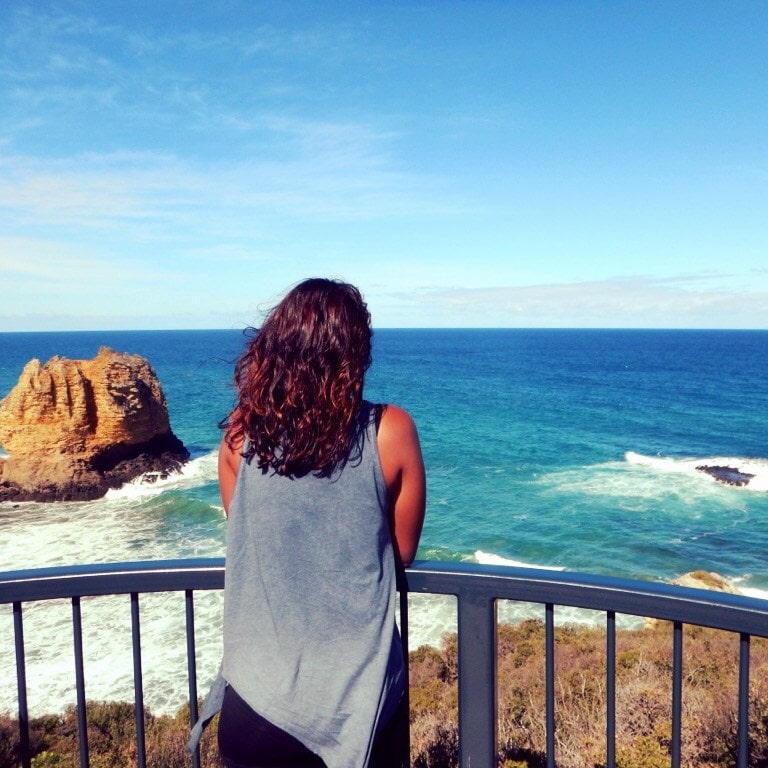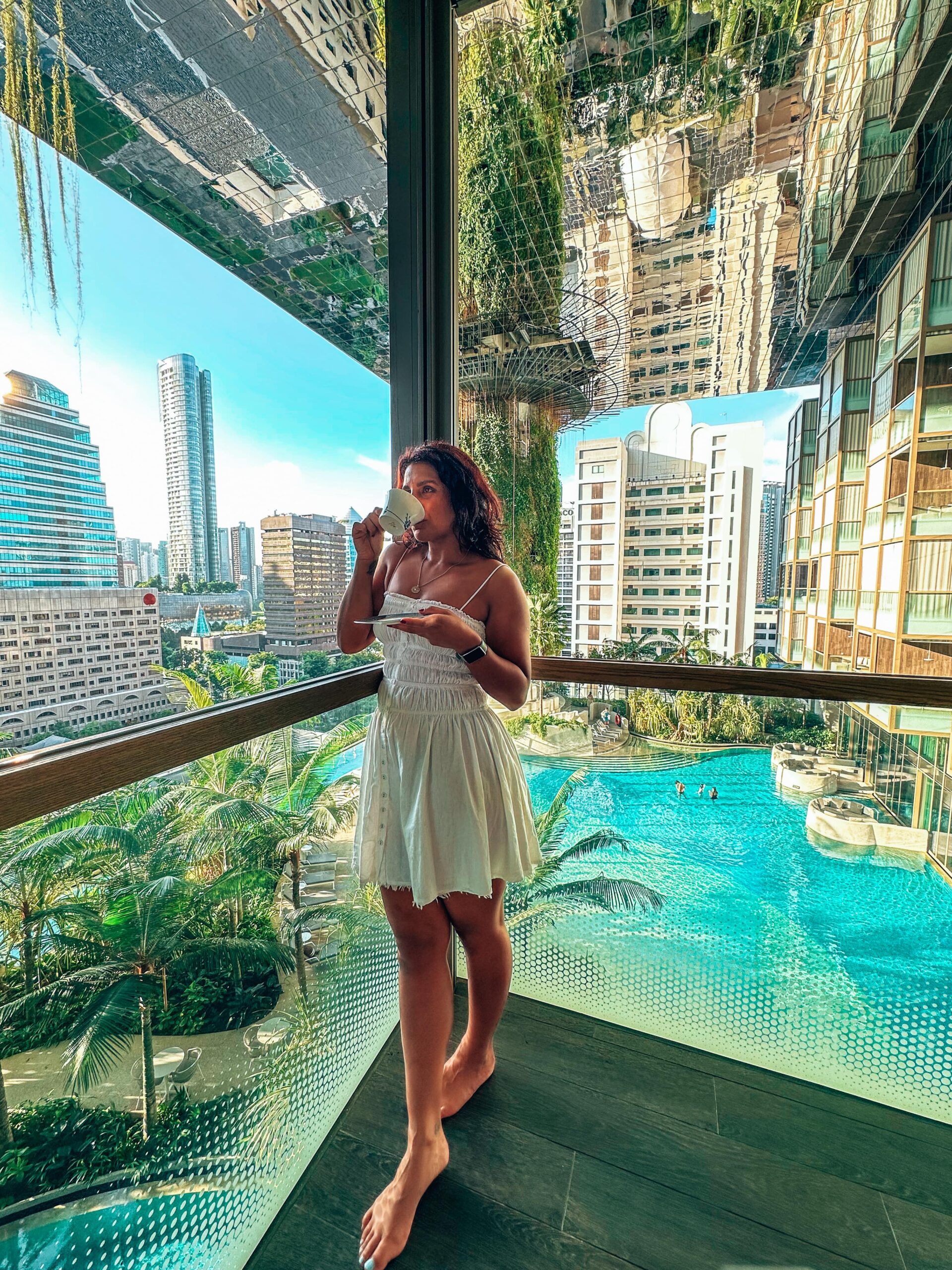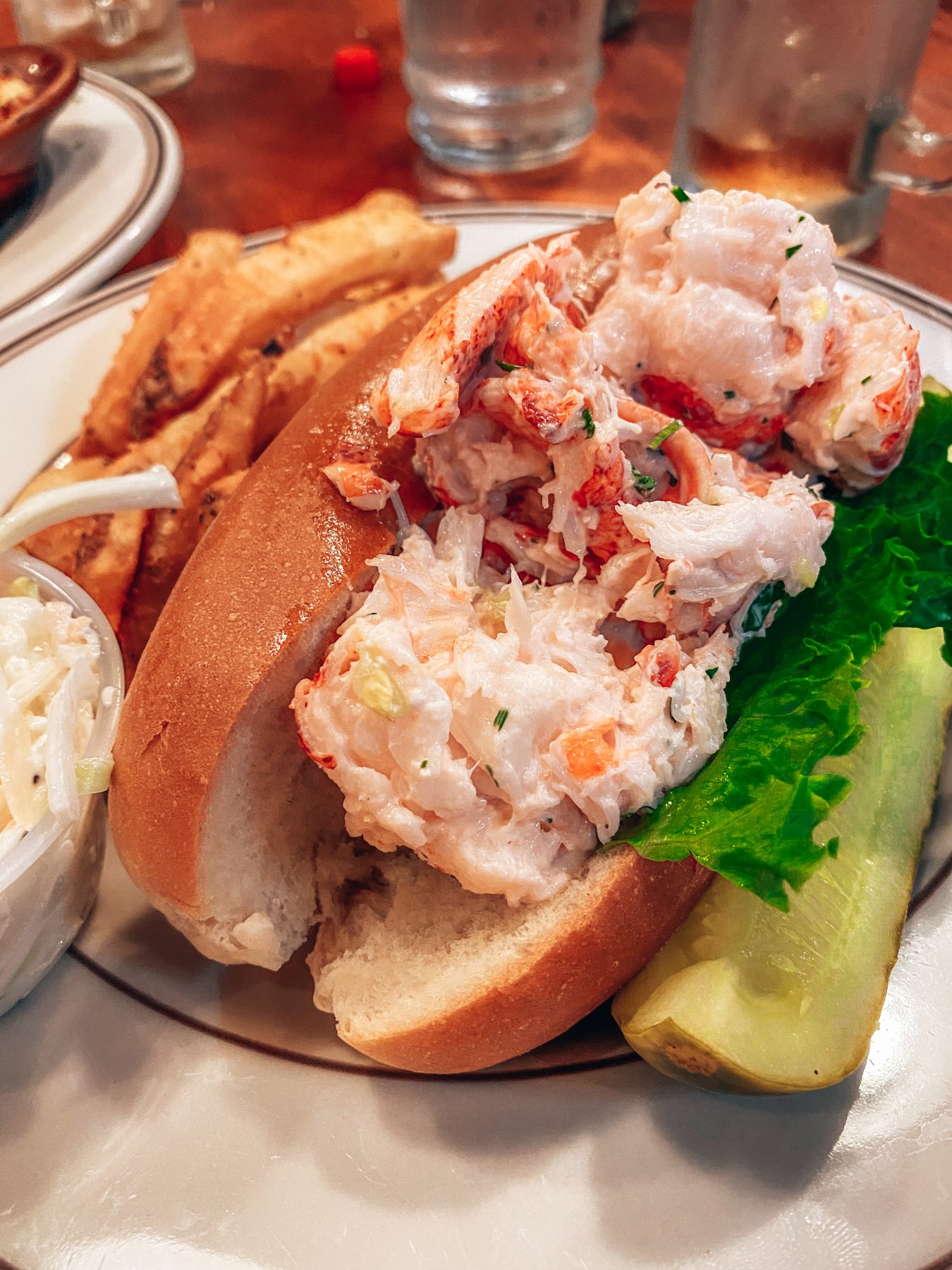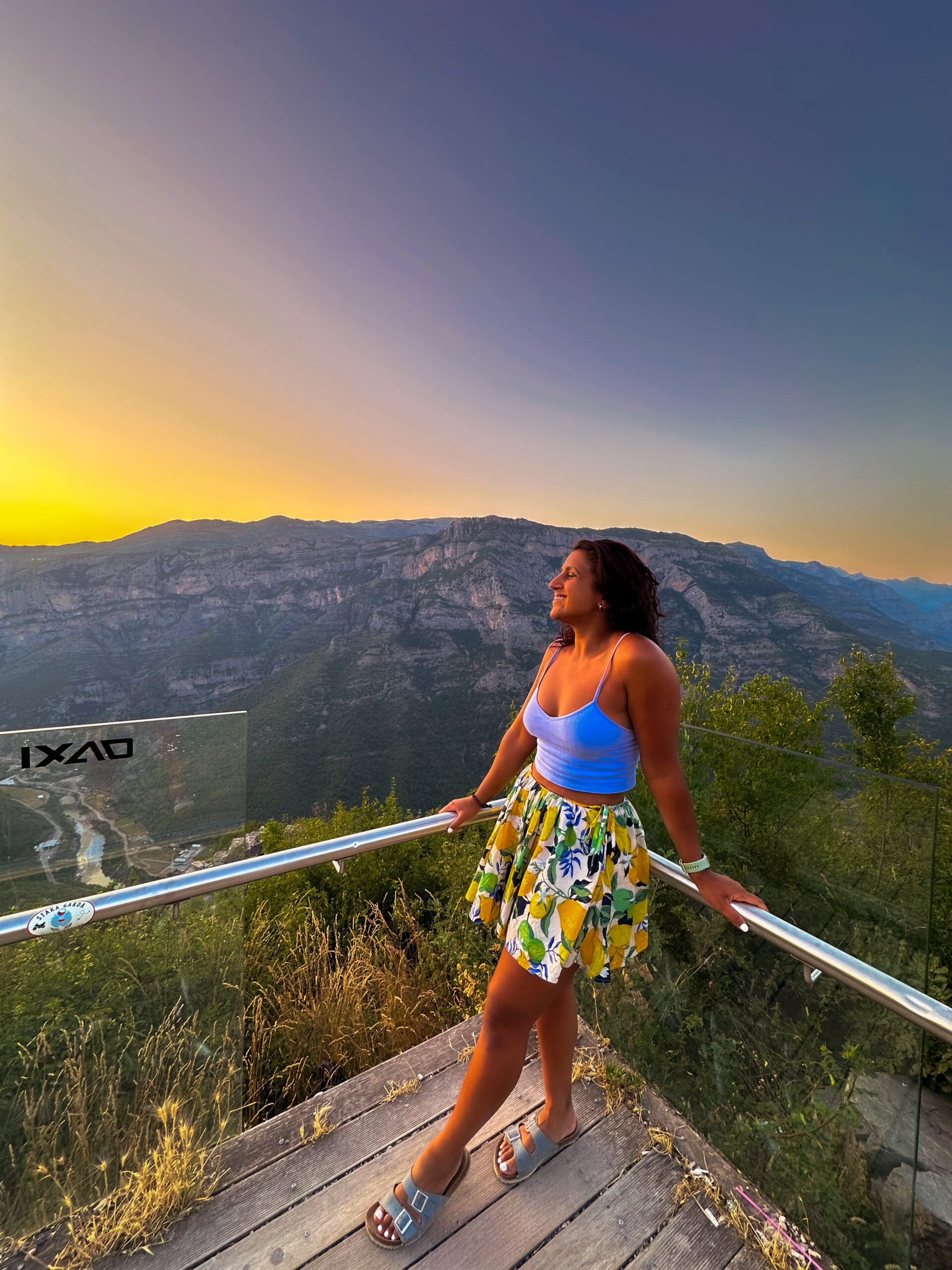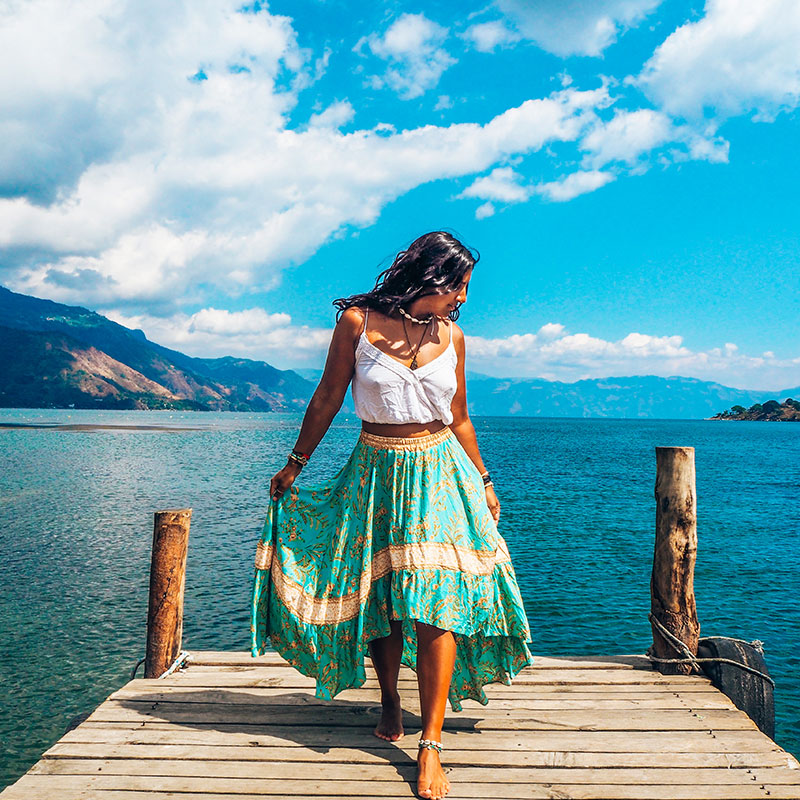Spending two years exploring the sunshine continent of Australia with a working holiday visa is one of the best travel experiences I’ve had. As a solo travel expert, spending the last decade voyaging the globe and touching down in over 50 countries, I know exactly what it’s like to be facing an Australia working holiday visa, and the essentials needed for a smooth and wholesome experience!
My travels are usually limited to a few months due to visa restrictions, but obtaining an Australia working holiday visa meant I could do far more than sip smoothies on the Gold Coast! A significant portion of my Australian adventure was spent living in Darwin and Melbourne; two cities I am eternally grateful to have called home. Cities have a magical way of encapsulating me, and I found myself feeling right at home in the bustle of Melbourne’s streets, seeking out local coffee joints to enjoy my morning brew.
Australia isn’t the cheapest country for solo travel, but my two-year visa let me work and travel simultaneously so I was always keeping my pennies topped up. So, what was it like getting a working holiday visa for Australia? Initially, the idea was a little intimidating, but after booking my flights and reading my Australia Lonely Planet, everything was smooth sailing. The hardest part became squeezing everything into my bag and roughly planning my next two years in the sun! This blog post is jam-packed full of all the tips and advice to make your Australian working holiday visa a breeze – from applying, to moving to Australia, to settling in to your new home.
Going to Australia on a Working Holiday Visa? Here's where you'll find:
- What is a Working Holiday Visa?
- Are Backpackers Allowed to Work in Australia?
- Can I Move to Australia From the UK Without a Job?
- Can I Go To Australia on a Tourist Visa and Find a Job?
- What’s The Difference Between a 417 and 462 Visa?
- Eligibility for Australia’s Working Holiday Visa
- Which Countries are Eligible for a Working Holiday Visa in Australia?
- Applying for a Working Holiday Visa in Australia
- How Much Money do you Need for a Working Holiday Visa in Australia?
- How to Get a Working Visa for Australia From the UK?
- How to Save up to $150 on Your Trip to Australia
- Can You Get a Second Working Holiday Visa for Australia?
- Do Brits Still Have to Do Farm Work in Australia?
- Moving to Australia with Global Work and Travel
- Travel Insurance for Working Holiday Visas
- Finding Cheap Flights to Australia
- Finding Hostels and Hotels in Australia
- Connecting with Other Travellers
- Things to Do When You Arrive in Australia
- Tips for Finding a Job in Australia
| Essentials for Australia |
| Find cheap flights to Australia |
| Find hotels or hostels |
| Find activities and tours for Australia |
| Get an eSIM for Australia |
What is a Working Holiday Visa?
Working holiday visas are golden opportunities for adventurers looking to spend longer in a country, supported by a temporary job. This could be farm or campsite work, cooking in a hostel, or even coffee shop serving. Gaining one of these permits was the only way I could spend so long in Australia, and my trip wouldn’t have been the same without it.
Working holiday visas aren’t solely limited to Australia. Many other countries like Canada, Japan, and New Zealand also offer similar opportunities, though specific requirements can vary. If you’ve got your soul set on spending extensive time in a country, looking into working holiday visas is a must!
Are Backpackers Allowed to Work in Australia?
Whether you’re heading to Australia with a suitcase or a backpack, you can find work! The Australian working holiday visa for UK citizens targets 18-35-year-olds and no longer requires travellers to spend months working in specific industries like plant and animal cultivation, fishing, tree farming, and construction. Check out my tips for finding backpacker jobs in Australia.
Can I Move to Australia From the UK Without a Job?
Taking the leap to permanently move to Aus from the UK without a job is only really possible if you have a family member that’s a resident or citizen in the country. A selection of visas exists for those without a job offer, including:
- General Skilled Migration
- Family-Sponsored Visas
- Student Pathway Visa
Since I didn’t qualify for any of these and wanted to stay in Australia for two years, I stuck with a working holiday visa. Back when I took my trip to Aus, I had minimum job requirements to get my second-year visa. I’d only ever worked remotely or in the UK, so I was a little apprehensive about how difficult it would be to land a job. To my pleasant surprise, however, it was a breeze and I’d scored two job opportunities within my first day!
Finding a job in a new country may seem daunting, but fear not! After scouring the internet and posting on social media that I was looking for a temporary role, I was nudged in the direction of hospitality within hours. Depending on the season and availability, there are always businesses looking for an extra pair of hands who gladly open the door to backpackers. Learn more about my Australian job-hunting experience.
Can I Go To Australia on a Tourist Visa and Find a Job?
Researching travel visas can feel like navigating a minefield with the amount of information out there! But to put things simply, if you want to work and travel Australia, a tourist visa won’t cut it. This type of visa is perfect for travellers looking to spend up to three months in Australia. If you’ve got your heart set on way more time while making money to support your travels along the way, a working holiday visa is the best way to work and travel Australia.
Some common jobs I stumbled across during my 24 months were waitressing, farm work (thinking cattle farms and fruit picking), hostel work, bar jobs, construction, general labour, and more! I worked as an au pair in Charleville, Queensland and it was one of the toughest roles I’ve ever experienced. I always see challenging situations as an opportunity for growth, but my time as an au pair pushed me past my limits. Read my experience in detail.
What’s The Difference Between a 417 and 462 Visa?
Two of the arguably most popular visas for Australia are the 417 Working Holiday Visa and the 462 Work and Holiday Visa. They might sound the same, but there are some key differences between the two.
Subclass 417 Working Holiday Visa
This temporary visa allows travellers between 18- 30 (or 18- 35 for some countries including the UK) to live, work, and explore Australia for 12 months. Eligible countries include Canada, Belgium, Denmark, France, Germany, Sweden, the UK, and many more. Conditions include a valid passport, online application from outside of Australia, and not having previously explored Australia on a 417 or 462 visa.
Subclass 462 Work and Holiday Visa
The 462 visa is very similar and permits travel, work, and living in Aus for up to 12 months. Travellers must be between 18 and 30 years old and eligible countries include the US, Thailand, Turkey, Greece, Indonesia, Poland, Portugal, and many more. You’ll need a valid passport, education requirements, sufficient funds, a supporting letter from your country’s government, and evidence of functional English.
Eligibility for Australia’s Working Holiday Visa
Whether I’m planning a 6-week Europe trip or a long-haul overseas adventure, I always make sure my documents and visas are in line. Not only is this the right thing to do, but it’s also a surefire way of minimising the risk of disruption when you touchdown.
What are the Criteria for a Working Holiday Visa in Australia?
There’s nothing too gobsmacking about the requirements for a working holiday visa in Australia! The main considerations are for travellers to be 18-30 (these figures may vary depending on different countries), hold a valid passport with adequate validity, disclose criminal convictions, and have proof of sufficient funds (AUD 5000). It’s also standard practice to disclose health information and you may be required to undertake a medical examination if requested by Australian authorities.
Information about Australia’s working holiday visa can make heads spin and palms sweat, but Global Work and Travel have every type of adventurer covered. Offering a guaranteed job match before arrival, a trip coordinator, comprehensive visa guidance, private airport transfer and plenty more, Global Work and Travel are an ideal place to get your ducks in a row before heading down under!
How Hard is it to Get a Working Holiday Visa for Australia?
Obtaining a working holiday visa for Australia, although a lengthy process, isn’t too difficult! Provided you have the correct documents such as a valid passport, and the right online application, you shouldn’t hit many bumps in the road. Applications can be processed as quickly as two weeks, but don’t panic if this time passes and you still haven’t received an update. Never be afraid to chase things up, particularly if you have a flight booked – my application was lost and only went through an hour before my flight thanks to my chasing it up!
Australian immigration authorities receive a hefty amount of applications, so it’s not uncommon for applications to take longer to process. If you find yourself feeling anxious and nervous but you’ve completed every step accurately, remind yourself of the golden beaches, koala bears, and vibrant cuisine awaiting your arrival!
Which Countries are Eligible for a Working Holiday Visa in Australia?
Country eligibility for a working holiday visa in Australia varies depending on the subclass 462 and 417 visas. Regardless of your country of origin and the correct visa for your travel plans, it’s vital to have the correct documents and a valid passport with enough validity to span the duration of your trip.
For the 462, eligible countries include:
- Argentina
- Austria
- Chile
- The People’s Republic of China
- Czech Republic
- Hungary
- Indonesia
- Israel
- Luxembourg
- Malaysia
- Peru
- Poland
- Portugal
- San Marino
- Singapore
- Slovak Republic
- Slovenia
- Spain
- Switzerland
- Thailand
- Turkey
- USA
- Uruguay
- Vietnam
For the 417, eligible countries include:
- Belgium
- Canada
- Cyprus
- Denmark
- Estonia
- Finland
- France
- Germany
- Hong Kong
- Republic of Ireland
- Italy
- Japan
- Republic of Korea
- Malta
- Netherlands
- Norway
- Sweden
- Taiwan
- UK
One of the most enjoyable, fulfilling aspects of solo travelling the world for the last decade is the incredible and diverse souls I’ve bonded with along the way. Meeting travellers from other countries has expanded my knowledge, allowing me to see locations from a myriad of perspectives other than my own. The fact Australia opens its doors to so many travellers cements my love for this glorious country and lets so many others see its beauty too.
Applying for a Working Holiday Visa in Australia
I don’t know what I’d have done without my Australian working holiday visa. It was the gateway for me to spend as much time on the continent as possible while supporting each step of my journey with reliable income on the ground. I’m not denying the application felt intense and gave me butterflies in my belly, but this small discomfort let me venture into a new world where pristine beaches, the Great Barrier Reef, and the depths of the Outback awaited me.
How to get a Working Holiday Visa in Australia?
The first step to getting an Australian Working Holiday Visa is to create an ImmiAccount through the Australian Government. Once your account is set up and ready to go, you simply need to fill out the required information. Have all of your documents like your passport, police certificate, and proof of sufficient funds to hand to make things easier.
How Much Money do you Need for a Working Holiday Visa in Australia?
To successfully apply for a Working Holiday Visa in Australia, you’ll need to show sufficient funds of AUD 5,000. It’s no secret that Aus isn’t the cheapest country to travel to, so it’s wise to save up more than this if you can! This means less financial stress on the ground before you start building funds back through work.
Can you Work in Australia with a Working Holiday Visa?
As the name hints, you can absolutely work in Australia with a Working Holiday Visa! If it’s your first extended trip in Aus, and you’re eligible for a 417 or 462 visa, you are permitted to work during your stay. This includes full-time, part-time, and more casual work depending on personal preference and what works best for the parts of Australia you’ll be travelling to.
Is it Difficult to Get a Working Holiday Visa in Australia?
I think the hardest part about the Australian Working Holiday Visa is the lengthy application and making sure everything is filled in correctly! As long as you meet all the criteria and apply for the correct visa, it should be smooth sailing. The process is a little complicated and stress-inducing, so I’d advise making a brew and calming your mind before logging in and starting the application!
How to Get a Working Visa for Australia From the UK?
UK citizens can get a Working Holiday Visa for Australia by applying for the subclass 417 visa with the correct documents and criteria. This year, however, the Australian and UK governments devised new regulations for the Working Holiday Maker (WHM) program and Youth Mobility Scheme.
From July 2024, UK passport holders can obtain three Working Holiday Visas without meeting specified work requirements, and this is open to those aged between 18 and 35.
How Much Does an Australian Working Holiday Visa Cost From the UK?
The cost of applying for an Australian Working Holiday Visa will set you back roughly AUD 635 (£321). This is a baseline price which may fluctuate, but it’s been around this amount for some time. You can check the cost of the application before completing the process to ensure you have adequate funds.
How Hard is it to Get a Working Holiday Visa for Australia?
For me, the biggest challenge with the Australian Working Holiday Visa was keeping patient! It’s a lengthy process and you’ll need documents to hand for inputting personal details and dates such as your passport and a police check. Each step of the process gets you a little closer to your dream Aussie trip, so keep calm and make sure you enter every detail accurately!
How to Save up to $150 on Your Trip to Australia
Being able to work and travel Australia is an absolute gift, but what if I told you it’s possible to save up to $150 on your overseas adventure? Welcome to Travel is a tour operator based in Sydney who knows how scary it can be to move Down Under for a year or more.
They provide welcome tours in Sydney, Melbourne and up the infamous East Coast to help travellers feel confident for the rest of their time in Australia AND give them the most unforgettable travel experiences! They've given me some exclusive discount codes for you to save up to $150 on a trip to Australia:
- AUD 50 discount on Welcome Tours using code LUCY50
- AUD 100 discount on East Coast Tours using code LUCY100
- AUD 150 discount on Package Tours using code LUCY150
Not only will these tours give you the opportunity to explore some of Australia’s most well-known places, but you’ll also be able to meet other solo travellers on their first Aussie trip too! Wave goodbye to stomach-churning nerves and welcome warm, open-arm energy with Welcome to Tour guiding you through every beginning step of your journey.
Getting Your Second Year Visa
I loved Aus so much that getting my second-year visa was a no-brainer. After all, it’s such a vast country and even after a year there, I still had so much to explore and experience. I knew I wanted to spend another year travelling up the West Coast and Tasmania, so I applied for the visa as soon as I was out of the country.
Can You Get a Second Working Holiday Visa for Australia?
When your first issued Working Holiday Visa is drawing to a close, you may be considering staying in Australia for another year, and this is possible by applying for a second visa! The cost and requirements are virtually the same as your first application but you must have completed at least 3 months of visa-specified work in regional Australia.
If you complete 6 months of 417-specified work during your second year, you can become eligible for a third Working Holiday Visa, making your total stay in Australia 3 years long! The new regulations for the Working Holiday Maker (WHM) program and Youth Mobility Scheme mean UK passport holders can get three Working Holiday Visas without meeting specific work conditions, but citizens from other countries aren’t included in these new rules.
Do Brits Still Have to Do Farm Work in Australia?
Farm work isn’t mandatory, but it’s something so many travellers do and love to qualify for their second-year visa and learn plenty about Aussie wildlife while doing so! Typical farm work, especially in the Outback can include caring for livestock, carrying out essential farm maintenance, harvesting and cooking fresh crops, or managing horses. As much as my experience was really challenging due to my employer, I do also recommend doing it (or some kind of rural work) because it is such an unique and unforgettable experience.
What Jobs Qualify for a 2nd Year Visa in Australia?
Hospitality may be high on the job list for travellers heading Down Under, but there are abundant jobs that qualify for a second-year visa far different from working behind a bar or serving tables. Although region-specific, these roles include tree farming and felling (in the north), plant and animal cultivation, fishing (in the north), and construction across various regions.
Moving to Australia
Australia is over 9,000 miles away from the UK when travelling by air, so moving there for two years was a big undertaking! As soon as the plane touched down, I knew I’d made the right decision and couldn’t wait to start my Aussie adventure. Moving abroad for any length of time comes with some big considerations, but being prepared beforehand makes everything run smoother than vegemite.
Moving to Australia with Global Work & Travel
I’ve worked with many companies over the years which helps support my travels and the blog you’re reading now! I’m always cautious about the companies I collaborate with, only working with those who put travellers first. That’s why I want to take a minute and write about Global Work & Travel.
Working Holiday in Australia (Lite)
Travelling smart means having essentials in place before jetting off overseas, and Global Work & Travel’s Working Holiday in Australia package is a winning solution nearly 100,000 travellers have relied on. Suitable for those aged 18- 35, the Lite package offers an incredible amount of support at an affordable price. Here’s a selection of what this package offers:
- Job match
- Exclusive app access
- Dedicated trip coordinator
- Guidance with flights, insurance, visa application, and accommodation
- 3 night’s hostel accommodation in Melbourne
- Private airport transfer
- Global emergency line
- Local team support
- And so much more!
Organizing a trip to Australia involves many moving parts from booking flights, accommodation, and transport to arranging work and in-country flights. With the Working Holiday in Australia Lite solution, the load is shared with experts who have been helping travellers since 2008.
Working Holiday in Australia (Plus)
For a more comprehensive approach, delve into more than just the essentials with Global Work and Travel’s Working Holiday in Australia Plus package. Also open to travellers aged between 18- 35, this option opens the door to local experiences, dependable support, and permanent resources such as:
- Job support across Australia
- Second-country job match
- Aussie Experience Day (Melbourne*)
- Aussie Experience Day (Gold Coast)
- Personal Travel Concierge
- Surf lesson (Gold Coast)
- Local life essentials
- Skydeck tour (Melbourne)
- "Welcome to Australia" virtual orientation
- And more!
With a money-back guarantee, there’s really nothing to lose by opting for the Working Holiday in Australia Plus. Global Work & Travel are pros in supporting travellers through every part of their Australian adventure, and having a reliable fall-back during any bumps in the road is indispensable.
Travel Insurance for Working Holiday Visas
When I took my first solo trip (over a decade ago!), I was a little naive and didn’t consider the importance of insurance. I didn’t encounter any issues or need to reach out to an insurance provider all those years ago, but with over 50 countries under my belt, I can’t express how much peace of mind I have when I invest in dependable insurance.
Choosing the right travel insurance can be a complicated process, and over the years I’ve opted for policies with various companies. SafetyWing's Nomad Insurance is the policy I turn to time and time again for its thorough support, covering over 175 countries. SafetyWing has a profound understanding of solo travel, and dedication to keeping travellers safe and supported no matter where they are in the world.
They've recently expanded coverage to include adventure sports and electronics theft too. Think of it as your safety net, if something goes wrong it's great to have a reserve plan in case you get sick, injured or your kit gets damaged. SafetyWing provides Travel Insurance for Nomads offering global coverage that can be purchased while outside your home country, with a simple claims service and 24/7 human support. Their cover provides the following:
- Meals & accommodations if you have a travel delay over 12 hours
- Emergency dental care up to $1000
- Medical care including prescriptions, emergency care and hospital stays
- Coverage for lost checked luggage
- Flights home if something bad happens
- Continued coverage for visits back home
- Coverage for motor accidents
- Coverage for injuries from leisure sports & activities
Read my full blog post on Choosing Travel Insurance for Solo Female Travellers.
Finding Cheap Flights to Australia
Flights are often the biggest expenditure of a trip, especially when flying from the UK to Australia! Since Aus is so far from the UK, average prices cost at least £400, but this can vary depending on the destination in Australia, the layover location, and the time of year you fly. Read my blog covering an array of tips to get cheap flights, and check out a few below:
Fly Off Peak
Travelling during peak season guarantees a couple of things. Firstly, prices will be considerably higher as peak season is a popular time to travel. Secondly, flights will be busier and potentially less enjoyable if you prefer to fly in solitude! Aussie high season is during the UK’s bleak winter, hence why so many travellers venture to Aus for some winter sun. Opting for March, April, or May is a far safer bet for a quieter and cheaper flight.
Choose Early Flight Times
Less convenient flight times like early morning may mean whipping up a brew at 2 am, but it can also mean saving precious pennies! Awkward flight times like early morning departures don’t appeal to the masses, so you can grab yourself a bargain simply by setting your alarm before the sun has risen into the sky.
Consider Two layovers
Flying from the UK to Australia means facing a layover. This could be in Dubai or Malaysia, but what about facing two layovers? Trust me when I say I’m not crazy, but sacrificing some time with two layovers can be surprisingly cheaper than settling for a single stopover. Why not consider it part of the adventure, especially if it means holding onto more money to spend when you land Down Under?
I always trust Skyscanner for when browsing for cheap flights to Australia as I can tailor the date ranges, airports and locations to uncover the best prices possible. There’s no reason to pay more for flights when Skyscanner gathers the best array of prices for various locations, airlines, and date ranges in one convenient place.
Finding Hostels & Hotels in Australia
Hotels offer a slice of luxury when travelling, but to save on budget and create the opportunity to meet other travellers, I tend to opt for hostel accommodation and book Australia hostels through Hostelworld. Starting your Australian journey in a hostel makes meeting other travellers a breeze, so you can find your feet and gain confidence before venturing further into your trip. After you feel more settled and have a network of other travellers beside you, then you can search for an apartment or house for long-term accommodation to support the activities you’ll be doing!
If you prefer to book a hotel until you get settled, I recommend looking on Hotels.com for great deals on hotels in Australia – hot tip – you can save money on your booking by getting a VPN like Surfshark and set your location to your destination and Indonesia to compare, often the prices will be much cheaper by changing your location while you book.
Connecting with Other Travellers
Meeting other people while travelling is a huge part of making memories and creating long-lasting experiences. I’m still in contact with so many of the beautiful people I’ve met from my travels through Asia, Europe, America, and of course, Australia. It’s crazy to think that these people were once strangers, but by exploring parts of countries together and taking part in activities like snorkelling, campervanning, and boat journeys, friendships grow.
I vow to always be open and honest about my experiences as a solo traveller and to tell the truth, I sometimes experience moments of loneliness. I talk more about battling loneliness as a solo traveller, but opening myself up to friendships is one of the key ways I combat these feelings. If you’ve just landed in Australia and don’t already have friends waiting for you, here are some key ways I bond and plant the friendship seeds that blossom into budding connections:
Stay in Hostels
Hostels are hubs of community! I will say it over and over again because it’s true, but hostels really are a guaranteed way of meeting other travellers, especially those on a solo mission. Hang out in the communal parts of hostels like the bar or games room and conversation will start flowing quicker than you can eat a Tim Tam bar!
Keep Open Body Language
When we feel self-conscious or anxious, it’s normal to adopt closed body language, but I challenge you to push past this! When you walk into a room of other travellers own the space. I don’t mean sashaying into the space like you’re on a catwalk, but hold your head high, smile, make eye contact, and people will want to spark a conversation.
Take a G Adventures Tour
If I have enough budget, I love taking a couple of tours during a trip, and in Australia, there are incredible options from bushwalking and surfing to dedicated adventures along the East Coast. The best way to book these tours? Using G Adventures group trips is the perfect way to save money on package adventures and meet other people travelling solo too.
Things to Do When You Arrive in Australia
To get yourself in the best position when you land in Aus, I’d recommend getting essential things sorted ASAP. It may seem a little mundane, but sorting things like a bank account and SIM means you can start living like a local and feel increasingly more at home.
Tax File Number (TFN)
Head to an Australian Taxation Office to obtain the correct documents for a TFN. If you’re more comfortable arranging things online than in person, you can visit the Australian government website here and apply online. Ignore any websites asking for payment or fees because this is a free process.
Open a MyGov Account
You may not need access to your MyGov account until later in your trip for tax and superannuation (retirement contribution), but getting prepared will save any hassle or stress later on. Access this service here and make sure you save your login information because it will likely float to the back of your mind while you’re surfing in Sydney or feeding kangaroos in the Outback!
Arrange Work & Accommodation
I don’t usually like to map out accommodation for a whole trip as I often don’t have concrete plans of where I’ll be at certain times. But arranging the first few weeks can be helpful while you settle into your new routine. As for sourcing work, I hit the streets of Melbourne with my CV pretty much straight away to get the ball rolling with earning some Aussie dollars!
Open a Bank Account
When you start earning money, you’ll need somewhere for it to be paid into. Opening a bank account is a vital step in your journey, and is far safer than carrying abundant cash in your backpack. Commonwealth Bank is a popular option but remember to bring your ID and visa information for a stress-free process.
Buy a SIM
I bought a Telstra SIM which although is a pricier option, had great coverage throughout every region of Aus I travelled through. Buying a SIM right away was one of the best decisions I made as I could contact loved ones back home as well as keep in touch with new friends effortlessly.
eSIMs didn't exist when I travelled to Australia, but I would definitely recommend downloading one for your first few days until you get an actual SIM – it means you have connection the second you get off the plane. But just note that for a bank account you will probably need to have an actual Australian mobile number which you can't get from an eSIM.
Holafly are my go-to eSIM provider and I have a discount code ABSOLUTELYLUCY for 5% off at Holafly
Read my full blog post on the Best eSIM For Solo Female Travellers To Beat Roaming Charges for more information.
Initiate Medicare
The Department of Human Services (DHS) is the place to apply for your Medicare card which opens up the door to Australian healthcare if you need aid during your trip. Online applications usually process quicker than telephone applications with your Medicare card landing in the post just a couple of weeks after submission.
Finding a Job in Australia
Arranging your Australia working holiday visa is one thing, but finding a job is another challenge completely! My jobs were pretty diverse, ranging from hospitality and sales to an au pair and ticket seller. I cover sourcing jobs in Aus thoroughly in this blog, but here are some of my top tips to get you earning Down Under:
Hand Out CVs
There’s no shame in being old school and handing out CVs to bars, cafes, restaurants, and hostels. It’s exactly how I scored some awesome, well-paid jobs during my two-year trip and I would do the same thing again! Just make sure your CV is up to date with essential, relevant information and hand in every copy with a smile and friendly conversation.
Search Job Adverts Online
The internet can be such a gift, and it’s your best friend when looking for Aussie jobs. Scout job adverts online for the area you’re staying in and see if companies are open to hiring for short-term roles. The Backpacker Job Board is a go-to for finding a diverse range of jobs covering anything from fruit picking and second-year jobs to hospitality and au pair roles. Facebook backpacker groups for Australia are also a goldmine when it comes to finding jobs as you travel the country.
Use Agencies
Agencies exist to help people find jobs, and this is no different when searching for work in Australia. Communicate your situation and the length of time you’ll be in a specific area and see if agencies can match you with appropriate work so you can build savings while paying rent and taking part in epic activities.





